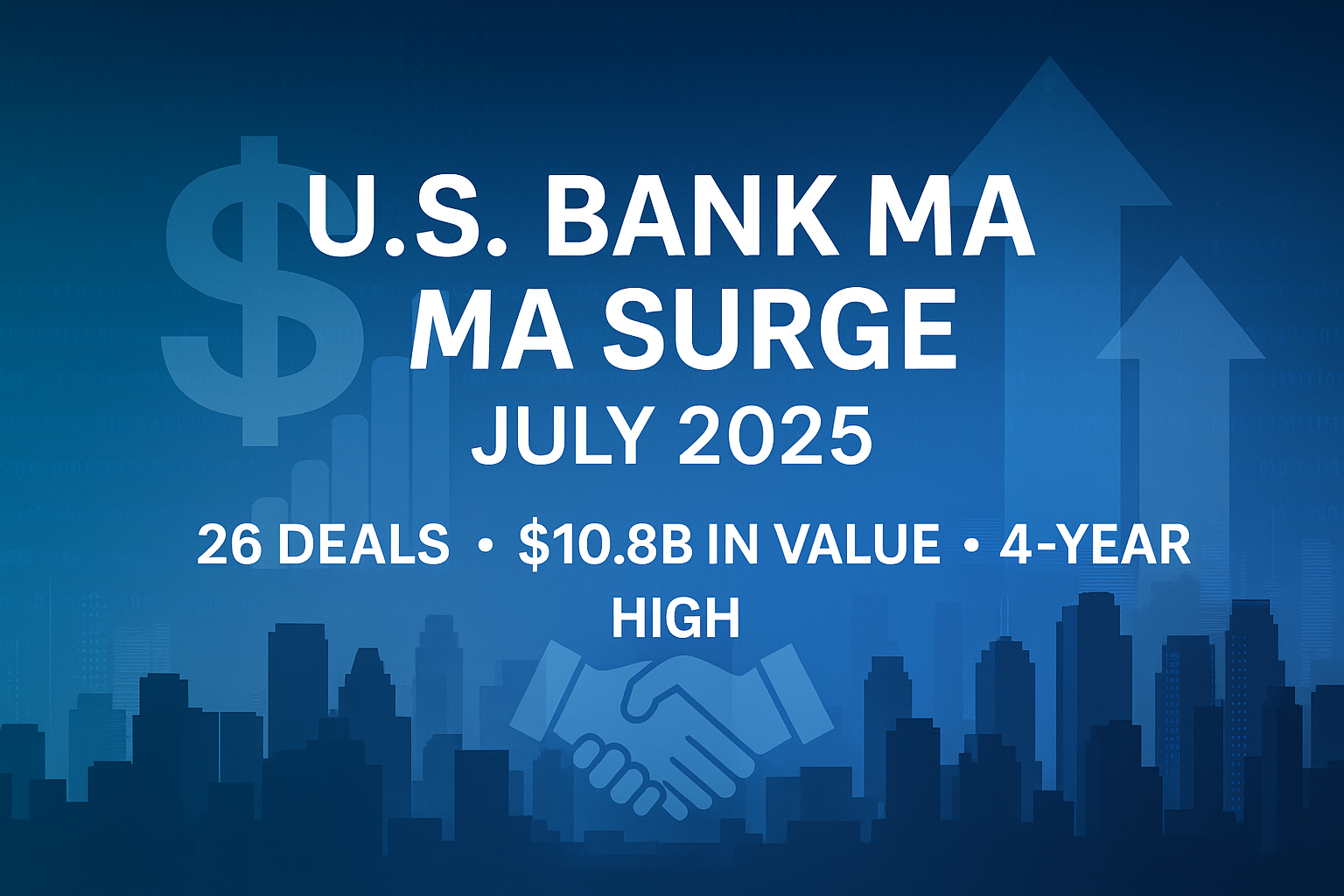U.S. Bank M&A Activity Hits Four-Year High in July 2025
July 2025 marked a milestone moment for the U.S. banking industry. Twenty-six mergers and acquisitions worth $10.83 billion were announced—the highest monthly total in nearly four years. (S&P Global Market Intelligence)
At the center of this surge was a $7.9 billion merger of equals between Pinnacle Financial Partners and Synovus Financial Corp., a transaction that alone represented nearly three-quarters of July’s total deal value.
The pace of consolidation reflects renewed confidence, shifting regulatory winds, and a strategic pivot toward scale—factors that are reshaping how community and regional banks plan for growth in 2026 and beyond.
Why Bank M&A Surged in July
1. A stabilizing rate environment
After two years of volatility, interest rates began to stabilize mid-2025. That created a more predictable backdrop for long-delayed M&A deals to resume.
2. Scale as a survival strategy
Technology investments, compliance demands, and margin pressures continue to squeeze smaller banks. Consolidation offers an efficient path to spread those costs and compete effectively.
3. Favorable regulatory posture
Recent supervisory reforms, including the Fed’s LFI rating framework proposal, signal a more pragmatic tone around “well-managed” designations. The regulatory climate is encouraging strategic—not speculative—growth.
4. Capital market optimism
Improved market valuations and reduced CRE exposure among mid-tier banks restored buyer confidence. That confidence is fueling a new wave of “merger-of-equals” transactions.
What This Means for Banking Executives
| Strategic Area | Implications |
|---|---|
| M&A Readiness | Banks should conduct readiness diagnostics—evaluating balance-sheet flexibility, credit quality, and operational integration capacity. |
| Valuation Positioning | Higher deal multiples mean stronger performers command premium pricing; underperformers risk being acquired at discounts. |
| Technology Integration | Seamless IT, cybersecurity, and digital banking ecosystems are critical differentiators for merger success. |
| Regulatory Relationships | With heightened scrutiny on cross-state mergers, maintaining proactive dialogue with examiners is essential. |
| Cultural Alignment | Leadership continuity and employee retention can determine whether “synergy” becomes reality or risk. |
How to Prepare for the Next Wave of M&A
Step 1: Strengthen your governance and control frameworks
Clean audits and resilient compliance programs reduce friction during due diligence.
Step 2: Develop a tested integration playbook
Document play-by-play transition procedures for IT, HR, compliance, and vendor risk management.
Step 3: Scenario-plan defensively and offensively
Model how your institution performs as both an acquirer and a target. Use those models to guide capital planning and communication with your board.
Step 4: Monitor peer activity
Track transactions in your geographic footprint or peer group. Early intelligence allows you to anticipate competitive shifts or acquisition interest.
In Context: Broader July 2025 Banking Trends
- The Fed’s July SLOOS report signaled continued tightening in CRE and consumer lending, reinforcing the need for cost and capital efficiency. (Federal Reserve)
- The Comptroller of the Currency, Jonathan Gould, was confirmed mid-month, suggesting continuity but fresh emphasis on operational resilience. (Wikipedia)
- Fintech partnerships accelerated as banks sought digital scale without full-scale acquisitions. (FinTech Futures)
Each of these dynamics reinforces one theme: the next 12 months will test how well banks convert size into strength.
How Saturn Partners Can Help
At Saturn Partners, we help financial institutions turn consolidation into a strategic advantage—not a scramble.
Our advisory and managed-security teams support banks through:
- M&A readiness assessments and cyber-risk due diligence
- Integration playbooks for IT, cybersecurity, and regulatory reporting
- Board-level dashboards mapping risk posture and value realization
- Continuous monitoring to protect merged environments during transition
Considering growth or guarding against takeover? Let’s build your M&A resilience plan, contact us today!

